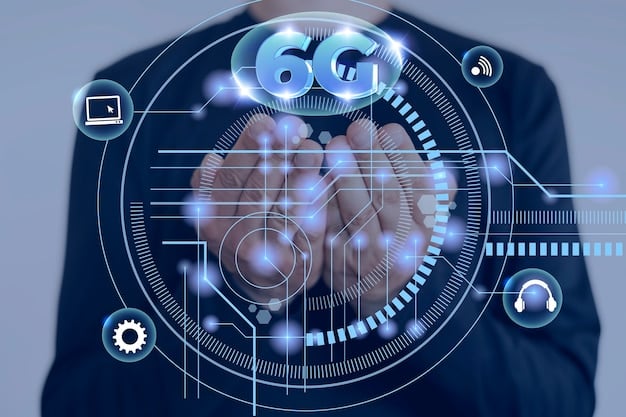5G Network Slicing to Revolutionize US Mobile by 2025

By 2025, 5G network slicing is set to fundamentally transform US mobile experiences, enabling tailored network performance for diverse applications from autonomous vehicles to immersive AR/VR, thus unlocking unprecedented efficiency and innovation across industries.
In an increasingly connected world, the demand for faster, more reliable, and highly specialized mobile experiences is surging. Traditional network architectures, while robust, often struggle to meet these diverse and stringent requirements. Enter 5G network slicing, a groundbreaking technological advancement poised to fundamentally reshape how mobile services are delivered and consumed across the United States by 2025. This innovation promises to unlock a new era of connectivity, tailoring network capabilities to specific applications and user needs with unprecedented precision.
Understanding the Core of 5G Network Slicing
At its heart, 5G network slicing is not merely an upgrade; it’s a paradigm shift in network management. It allows mobile network operators (MNOs) to segment their 5G network infrastructure into multiple virtual, independent logical networks. Each “slice” is optimized for a specific service, application, or customer, offering guaranteed quality of service (QoS) and performance parameters. This moves beyond the one-size-fits-all approach, providing dedicated resources and configurations for distinct use cases.
The concept relies heavily on software-defined networking (SDN) and network function virtualization (NFV) technologies. These foundational elements decouple network functions from proprietary hardware, enabling MNOs to create, deploy, and manage these virtual slices dynamically and efficiently. It’s akin to having several bespoke networks operating concurrently over a shared physical infrastructure, each behaving as if it were a standalone network.
The Foundational Technology: SDN and NFV
Software-defined networking (SDN) centralizes network control, separating the control plane from the data plane. This allows for programmatic management of network resources. Network function virtualization (NFV), on the other hand, shifts network functions like firewalls or load balancers from dedicated hardware appliances to software running on standard servers. Together, SDN and NFV provide the agility and flexibility required to create and manage network slices effectively.
- SDN: Centralized control, programmable network.
- NFV: Virtualized network functions, hardware independence.
- Dynamic Provisioning: Slices can be created and modified on the fly.
- Resource Isolation: Each slice operates independently, preventing interference.
This dynamic architecture means that a mobile operator can provision a slice optimized for ultra-low latency for autonomous vehicles, another for high bandwidth for enhanced mobile broadband (eMBB), and yet another for massive machine-type communications (mMTC) for IoT devices, all simultaneously on the same physical 5G infrastructure. This granular control over network resources is what sets 5G network slicing apart from previous generations of mobile networks.
Transforming Consumer Mobile Experiences: Beyond Blazing Fast Speeds
While 5G is widely known for its promise of blazing-fast speeds, network slicing elevates this by allowing unprecedented customization of the consumer mobile experience. By 2025, US consumers will likely encounter tailored network performance that caters directly to their activities, not just a general speed boost.
Imagine a gamer experiencing virtually zero lag during a competitive online match because their gaming platform has a dedicated low-latency slice. Or a binge-watcher enjoying 8K streaming without buffering, powered by a high-bandwidth slice reserved specifically for video content. This level of personalized service will significantly reduce common frustrations associated with network congestion and inconsistent performance.
Gaming and Entertainment: A New Era of Immersion
For gamers, network slicing means the difference between victory and defeat. A dedicated slice can prioritize gaming traffic, guaranteeing ultra-low latency and consistent connectivity, making cloud gaming services and competitive online multiplayer experiences seamless. This eradicates the infamous “lag” that plagues many online interactions.
- Cloud Gaming: Smooth, console-like performance on mobile devices.
- Esports: Reliable connections for professional and casual players.
- Immersive AR/VR: High bandwidth and low latency for realistic virtual environments.
Entertainment also stands to gain immensely. Virtual reality (VR) and augmented reality (AR) applications, often hampered by processing demands and network limitations, will thrive. High-definition content, especially 4K and 8K streaming, will be delivered flawlessly, even in crowded areas, as providers can allocate dedicated bandwidth slices to ensure a premium viewing experience. This translates into richer, more engaging content consumption, whether at home or on the go.
Revolutionizing Enterprise and Industry Verticals with Network Slicing
The impact of 5G network slicing extends far beyond individual consumers, spearheading a revolution in enterprise and industrial applications. By 2025, businesses across various sectors in the US will leverage customized network slices to power critical operations, enhance efficiency, and foster innovation on an unprecedented scale.
Consider the manufacturing sector: a dedicated network slice can guarantee the ultra-reliable low-latency communication (URLLC) required for robotic automation and real-time control systems on a factory floor. This ensures safety, precision, and maximizes productivity. Similarly, in healthcare, patient monitoring systems and remote surgery could rely on slices that prioritize security and ensure uninterrupted data flow, critical for life-saving applications.

Enabling Smart Cities and Autonomous Vehicles
One of the most profound transformations will be seen in the development of smart cities and the deployment of autonomous vehicles. These ecosystems demand a complex interplay of connectivity requirements, from massive IoT sensor networks to real-time vehicle-to-everything (V2X) communication. Network slicing provides the flexibility to create distinct environments for each.
- Autonomous Vehicles: Ultra-low latency slices for V2X communication, critical for safety and coordination.
- Smart City Infrastructure: Dedicated slices for traffic management, utility monitoring, and public safety.
- Emergency Services: Prioritized and secure slices for first responders, ensuring communication even in overloaded networks.
For autonomous vehicles, slicing is not just about convenience; it’s about safety. Dedicated URLLC slices can ensure that vehicles communicate instantaneously with each other and with roadside infrastructure, facilitating split-second decision-making. In smart cities, different slices can manage everything from smart streetlights and waste collection sensors to environmental monitoring and public safety cameras, each tailored to its specific latency, bandwidth, and security needs.
The Impact on US Healthcare: Precision and Remote Care
The US healthcare system, under increasing pressure for efficiency and advanced patient care, stands to benefit enormously from 5G network slicing. By 2025, mobile networks will no longer be a generic conduit but a specialized tool, offering unparalleled reliability and security for medical applications.
Imagine remote diagnostics operating with the same precision as in-person examinations, or emergency medical services receiving real-time, high-definition data from a patient in transit, enabling immediate treatment decisions. This level of connectivity can bridge geographical gaps, allowing specialists in urban centers to assist patients in rural areas, and transforming the landscape of telehealth.
Advanced Telemedicine and IoT in Healthcare
Network slicing will enable the next generation of telemedicine. High-definition video consultations, remote patient monitoring via wearable sensors (IoT), and even robotic-assisted surgeries from miles away will become more robust and reliable. Each of these applications requires specific network characteristics that can be met by a dedicated slice.
- Remote Surgery: Ultra-low latency slices for haptic feedback and real-time video, ensuring precision.
- Telehealth: High-bandwidth, secure slices for video consultations and large data transfers for diagnostics.
- Remote Patient Monitoring: Low-power, secure slices for continuous data transmission from medical IoT devices.
Furthermore, medical IoT devices, from continuous glucose monitors to smart inhalers, can operate on specific mMTC slices, ensuring efficient data collection and reliable transmission without draining device batteries or overwhelming the network. This not only enhances patient care but also provides healthcare providers with a wealth of data for proactive intervention and personalized treatment plans.
Security and Reliability: Building Trust in a Sliced Network
With the increasing reliance on digital infrastructure, security and reliability are paramount concerns. 5G network slicing inherently offers enhanced security capabilities compared to traditional networks by isolating different traffic types. By 2025, this will be a crucial factor in the widespread adoption of 5G across critical US infrastructure.
Each slice can have its own customized security policies and encryption protocols, meaning a breach in one slice does not necessarily compromise others. This micro-segmentation significantly reduces the attack surface and limits the potential damage from cyber threats. For sensitive applications like financial transactions or national security communications, dedicated and highly secure slices will be indispensable.
Tailored Security Protocols for Each Slice
The ability to apply specific security measures to individual slices ensures that applications with high security requirements, such as government communications or critical infrastructure control, can operate with an unparalleled level of protection. This is a significant improvement over previous network architectures where security measures were often generalized across the entire network.
- Isolation: One slice compromise does not affect others.
- Customizable Security: Tailored encryption and authentication per slice.
- Regulatory Compliance: Easier to meet industry-specific security standards.
Moreover, the reliability aspect is equally critical. By assigning dedicated resources and guaranteeing specific QoS parameters, network slicing ensures that vital services remain operational even under extreme network load or during emergencies. First responders, for instance, can be allocated a high-priority, resilient slice that functions even when public networks are saturated, ensuring critical communication pathways remain open.
Economic Opportunities and Business Model Innovation
The advent of 5G network slicing in the US by 2025 is not just a technological marvel; it’s a massive economic accelerator. This technology opens doors for telecommunication operators to innovate their business models, moving beyond simple data plans to offering specialized, value-added services. The ability to guarantee specific performance levels for different applications creates entirely new revenue streams and fosters a vibrant ecosystem of innovation.
Operators can partner with enterprises to provide dedicated network slices for their demanding needs, transforming from mere connectivity providers to enablers of digital transformation. This granular control over network resources allows for flexible pricing models based on QoS, latency, bandwidth, and security, creating a more dynamic and competitive market for network services.
Monetizing Specialized Network Capabilities
MNOs can monetize network slicing by offering “network-as-a-service” (NaaS) models, allowing businesses to activate and manage their own slices on demand. This transforms the traditional telco business model, opening up opportunities for new partnerships and customized service offerings.
- Tiered Services: Offering premium slices with guaranteed performance.
- Application-Specific Slices: Tailored connectivity for specific software or platforms.
- Dynamic Capacity: On-demand scaling of network resources.
Startups and established companies alike will find new avenues for innovation, developing applications and services that were previously impossible due to network limitations. From highly localized smart energy grids to sophisticated augmented reality tours, the flexibility and guaranteed performance of network slices will power a new generation of digital services, driving economic growth and job creation across the US.
Challenges and the Road Ahead for Widespread Adoption
While the promise of 5G network slicing is immense, its widespread adoption and full realization in the US by 2025 face several significant challenges. These include complex technical implementations, the need for new operational paradigms, and significant investment from mobile network operators. Overcoming these hurdles will be crucial for unlocking the full potential of this transformative technology.
One primary challenge is the orchestration and management of a multitude of dynamic slices. This requires sophisticated AI and machine learning tools to automate the provisioning, monitoring, and scaling of slices in real-time. Furthermore, interoperability between different operators’ sliced networks is essential for seamless national coverage and functionality, demanding industry-wide standards and cooperation.

Technical and Operational Hurdles
The transition from current network architectures to a fully sliced 5G environment involves more than just software upgrades. It necessitates re-architecting core network components, implementing advanced automation, and training personnel with new skill sets. The operational complexity of managing countless virtual networks, each with unique requirements, is substantial.
- Orchestration Complexity: Managing dynamic provisioning and scaling of slices.
- Interoperability: Ensuring seamless operation across different MNO networks.
- Standardization: Developing common protocols for slice definition and management.
Despite these challenges, the industry is making steady progress. Standards bodies like 3GPP are continually refining the specifications for network slicing, and major MNOs are investing heavily in the necessary infrastructure and software capabilities. As these technologies mature and best practices emerge, the path to a fully sliced 5G reality by 2025 becomes increasingly clearer, promising a future of unprecedented mobile experiences.
| Key Aspect | Brief Description |
|---|---|
| 🚀 Tailored Performance | Customized network slices for specific application needs (e.g., low latency for gaming, high bandwidth for streaming). |
| 🏭 Industry Transformation | Revolutionizes sectors like manufacturing, healthcare, and smart cities with dedicated, reliable connectivity. |
| 🔒 Enhanced Security | Individualized security policies per slice greatly reduce attack surfaces and enhance data protection. |
| 💲 New Business Models | Enables operators to offer Network-as-a-Service (NaaS) and specialized, monetizable connectivity solutions. |
Frequently Asked Questions about 5G Network Slicing
5G network slicing is a technology that allows a single physical 5G network to be divided into multiple virtual, independent logical networks. Each “slice” is optimized for specific services, applications, or customer requirements, providing tailored performance and dedicated resources.
For everyday US users, network slicing will offer significantly improved and more consistent experiences. It means dedicated performance for specific activities like ultra-low latency for mobile gaming, buffer-free 8K video streaming, and highly reliable connections for critical smart home devices.
By 2025, industries such as manufacturing, healthcare, and transportation are expected to benefit immensely. Slicing enables critical applications like robotic automation, remote surgeries, and autonomous vehicle communication with guaranteed performance, security, and reliability.
Yes, network slicing significantly enhances security. Each slice can have its own customized security policies and encryption protocols, logically isolating different traffic types. This micro-segmentation limits the impact of potential security breaches, preventing them from affecting other network segments.
Key challenges include the complexity of managing a multitude of dynamic slices, needing sophisticated AI and machine learning for orchestration. Additionally, ensuring interoperability between different operators’ sliced networks and establishing industry-wide technical standards are crucial for full deployment.
Conclusion
The advent of 5G network slicing is not merely an incremental improvement; it signifies a fundamental reshaping of mobile connectivity. By 2025, the United States will witness a profound transformation in how mobile experiences are delivered, moving from a generalized service to a highly customized, application-aware network. This innovation promises to unlock unparalleled efficiency, security, and innovation across consumer and industrial sectors, making the 5G network a truly intelligent and adaptable foundation for the digital future. The challenges along the path to full realization are significant, yet the potential benefits for personalized user experiences, industrial automation, and critical national infrastructure are too compelling to ignore, driving operators and developers towards this transformative era of connectivity.





